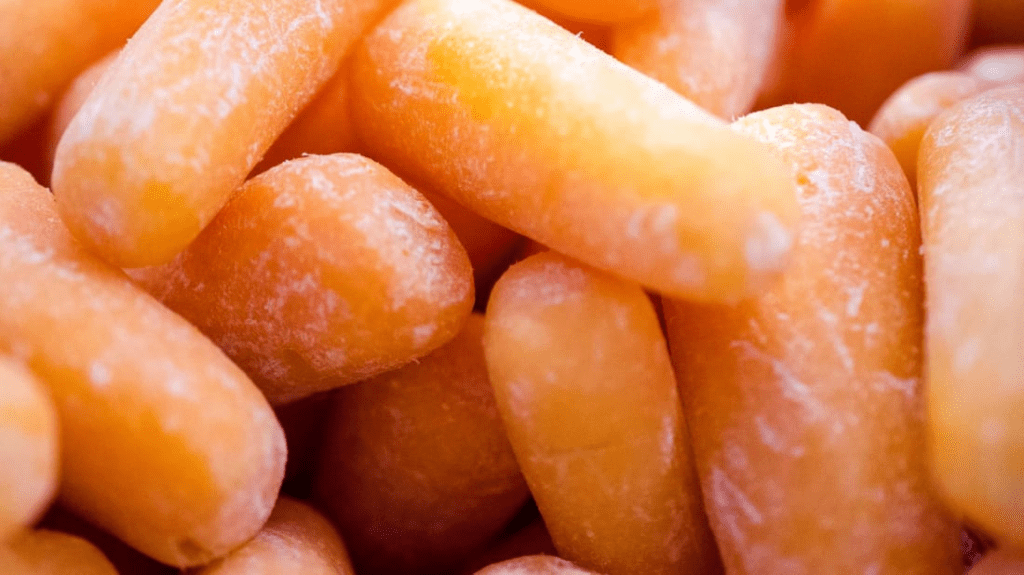Opening a bag of baby carrots only to find a strange white fuzzy coating can be unsettling. You might wonder whether these carrots are still safe to eat or if they’ve gone bad. Don’t worry, you’re not alone. Many people have experienced this exact situation and are often left with the same question: “Should I toss them out or can I still eat them?” In this article, we’ll explore what this white fuzz is, what causes it, and whether your baby carrots are still edible.
Understanding the White Fuzzy Coating on Baby Carrots

That white fuzzy layer you see isn’t always a sign of spoilage. In most cases, it’s either dehydration or a harmless fungus called mycelium. Let’s break down the two possibilities:
1. Dehydration: The Most Common Cause of White Blush
Baby carrots, unlike whole carrots, are peeled and shaped into smaller pieces, which exposes them to more air. This exposure causes them to dry out quicker, leading to what’s known as “white blush” or “carrot blush.” This white coating is more chalky than fuzzy and is simply the result of moisture loss. Thankfully, it’s just a cosmetic issue and doesn’t affect the carrots’ safety or flavor.
2. Mycelium: Harmless Fungal Growth
In some cases, the white fuzz you see on your carrots might be mycelium. This is a benign fungus that thrives in humid environments or when the carrots are stored improperly. While mycelium might look alarming, it’s usually not harmful to consume. However, it can sometimes indicate the beginnings of spoilage, so you’ll want to inspect the carrots closely before eating them.
Is It Safe to Eat Baby Carrots with a White Coating?
The million-dollar question: can you eat baby carrots with a white fuzzy coating? If dehydration is the culprit, the answer is yes. A simple rinse can restore their appearance and make them ready to eat. But if you suspect that the fuzz is mycelium, take a few extra precautions.
Here’s a step-by-step guide on what to do if you find white fuzz on your baby carrots:
1. Rinse Them Thoroughly
Start by washing the carrots under cool, running water. This will help remove any surface dirt or fungi and restore some of their crispness. If the fuzz is due to dehydration, it should easily wash away.
2. Soak in Ice Water for Extra Crunch
If the carrots look a little shriveled after rinsing, give them a soak in ice water for about 10 minutes. This will help rehydrate the carrots and bring back some of their original crunch.
3. Inspect for Other Signs of Spoilage
After rinsing, give your carrots a closer look. If they are slimy, have a bad odor, or still look fuzzy after washing, it’s best to discard them. These signs indicate that the carrots may be spoiled, and it’s not worth the risk.
How to Prevent White Fuzz on Baby Carrots
While encountering white fuzz on your carrots isn’t the end of the world, there are steps you can take to prevent it from happening in the first place. Proper storage is key to keeping your carrots fresh and fuzz-free.
1. Store Carrots in the Coldest Part of Your Fridge
Baby carrots do best when stored at low temperatures. Keep them in the coldest part of your fridge, typically the back of the vegetable drawer. The cool air helps prevent dehydration and fungal growth.
2. Maintain High Humidity Levels

Carrots love moisture, so keep them in a high-humidity environment. Most refrigerators have adjustable humidity drawers—use one of these for your baby carrots. This will slow down dehydration and keep them fresher for longer.
3. Use Airtight Containers
If the original packaging isn’t resealable, transfer your baby carrots to an airtight container or a resealable plastic bag. This minimizes air exposure, reducing the chances of dehydration and fuzz development.
4. Avoid Washing Before Storage
It might be tempting to wash your baby carrots right after bringing them home, but this can introduce excess moisture. Washing them before storage can lead to spoilage, so only rinse them just before you plan to eat them.
White Fuzz vs. Spoilage: Know the Difference

While white fuzz on baby carrots is usually harmless, it’s important to know the difference between harmless dehydration and actual spoilage. Dehydration results in a chalky white appearance, while spoilage often brings slime, a strong odor, or a soft texture. Trust your senses—if something seems off, it’s better to toss the carrots.
Conclusion: Don’t Be Alarmed by the White Coating
Finding white fuzz on your baby carrots doesn’t automatically mean they’re bad. In most cases, it’s just a sign of dehydration, and a quick rinse will bring them back to life. However, if the fuzz is accompanied by other signs of spoilage, it’s best to discard them to avoid any risk.
Proper storage techniques, such as keeping carrots in an airtight container and maintaining high humidity, can prevent this white coating from forming in the future. So next time you open a bag of baby carrots and see a white fuzz, don’t panic—just rinse, inspect, and enjoy!


